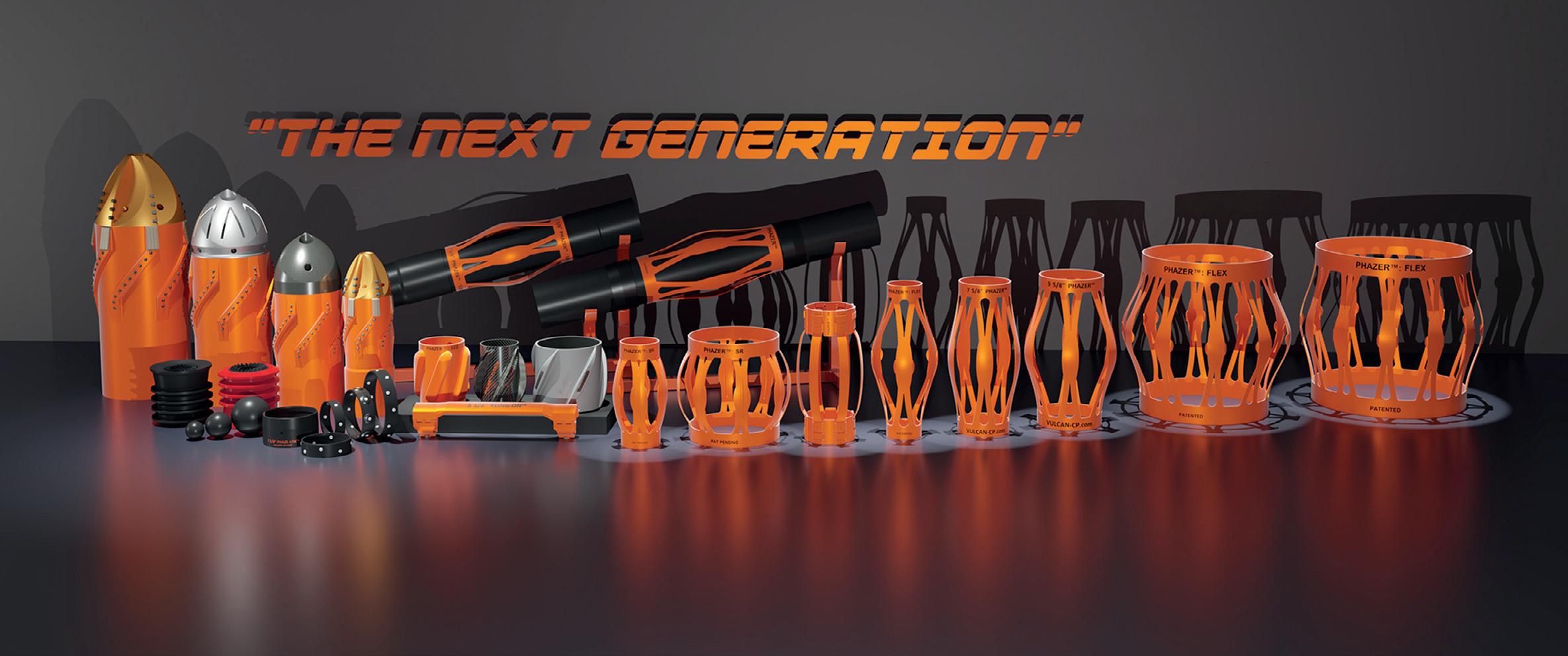
7 minute read
DRILLING AND WELL SERVICES INDUSTRY SEES BETTER TIMES AHEAD
By Tsvetana Paraskova
Drilling and well services activity has rebounded in recent months globally, due to higher oil and gas prices and a push for energy security. Even with the macroeconomic uncertainty, energy services contractors and oilfield services providers are expected to see a sustained period of increased order volumes thanks to a jump in the midstream segment and tightening oil and gas supply.
Top Providers See Structural Upcycle
At the beginning of this year, SLB (formerly Schlumberger), Halliburton, and Baker Hughes – the world’s three biggest oilfield service providers – reported for 2022 their highest annual earnings since the 2013-early 2014 oil price and US shale boom.
The structural upcycle in the oil and gas industry, which started in 2022, is set to turn into a multi-year upcycle for the drilling and well service providers, due to improving pricing and tight equipment and service capacity in several markets.
Growth in drilling in the Middle East, North America, and offshore globally has helped SLB over the past year, SLB’s chief executive Olivier Le Peuch said
“Additionally, pricing continues to trend favorably, extending beyond North America and into the international regions, supported by new technology and very tight equipment and service capacity in certain markets,” he added.
“Looking ahead, we believe the macro backdrop and market fundamentals that underpin a strong multi-year upcycle for energy remain very compelling in oil and gas and in low-carbon energy resources,” according to SLB’s top executive.
Rising oil demand despite concerns for an economic slowdown, energy security concerns, and investments in technology for decarbonisation are set to drive strong demand for drilling and well services going forward, said Le Peuch.
Another major oilfield services provider, Baker Hughes, reported record orders of $8.0 billion for the fourth quarter of 2022, up by 32% from the third quarter and up by 20% compared to the same quarter of 2021. Revenues also increased, to $5.9 billion for the fourth quarter of 2022, a 10% increase from Q3 and an 8% rise year over year.
“In 2023, the global economy is expected to experience some challenges under the weight of inflationary pressures and tightening monetary conditions. Despite recessionary pressures in some of the world’s largest economies, we maintain a positive outlook for the energy sector, given supply shortages appear likely to persist,” Baker Hughes chairman and CEO Lorenzo Simonelli said in a statement.
Baker Hughes continues to have a positive outlook on the industry because “With years of under investment now being amplified by recent geopolitical factors, global spare capacity for oil and gas has deteriorated and will likely require years of investment growth to meet forecasted future demand,” Simonelli added.
Baker Hughes also remains positive on the near term and long-term prospects for the investment cycle in natural gas supply and LNG.
In the near term, demand in Europe and the reopening of China are set to keep the global gas and LNG markets tight, Simonelli said on the company’s earnings call opportunities within geothermal energy, hydrogen, offshore wind, and carbon capture, utilisation and storage (CCUS), energy research firm Rystad Energy said in a report earlier in 2023.
“All signs point towards 2022 being the start of another super cycle for the energy services sector”, said Audun Martinsen, partner and head of energy service research at Rystad Energy.
Thanks to high demand for natural gas and LNG, overall oil and gas spending will stay above $920 billion annually on average for the 2022-2028 period, the research and data company noted.
“Despite the risk that another downturn cycle in oil and gas may occur after 2025, oilfield service suppliers should be able to balance out the downturn by branching out into other parts of the wider energy market – and in so doing, expanding the overall target market for contractors,” Rystad Energy said.
Energy service suppliers could balance a possible oil and gas sector downturn with continuous pursuit of obvious opportunities within geothermal energy, hydrogen, offshore wind, and CCUS.
Halliburton, the top fracking services provider, also reported a strong 2022 and said it expected a strong 2023.
“Longer term, we remain optimistic on the structural growth outlook for natural gas and LNG as the world looks to lower emissions and displace the consumption of coal,” he added.
Baker Hughes is also expanding into the new energies business by acquiring and investing in multiple new technologies around hydrogen, carbon capture, clean power, and geothermal, Simonelli noted.
Halliburton, the top fracking services provider, also reported a strong 2022 and said it expected a strong 2023.
Full-year North America revenue jumped by 51% over 2021 with improved margins driven by activity and pricing gains, Halliburton’s chairman, president, and CEO Jeff Miller said on the earnings call. Total revenue for the full year rose by 33% to $20.3 billion.
Referring to the US business, Miller said, “Given the increased spend required to grow and replace production, I expect activity to remain strong and service intensity to increase through 2023.”
“It’s clear to me that oil and gas is in short supply, and only multiple years of increased investment in both stemming declines and reserve additions will solve short supply. I believe these investments will drive demand for oilfield services for the next several years,” he added.
Globally, “The unique feature of this upcycle, as I see it, is the investor driven return discipline by both operators and service companies, which I expect drives a longer duration cycle and translates into years of increasing demand for Halliburton services,” Miller said.
Energy Services Market Set To Hit $1 Trillion in 2025
Energy services providers could see the market topping $1 trillion by 2025, due to demand for oil and gas supply and expansion into
“Together with oilfield services, this expansion into other energy areas could provide a $1 trillion market for suppliers by 2025, which could be sustained for several years after that,” Rystad Energy analysts noted.

Offshore Rig Outlook
Specifically in the offshore drilling and services business, rig activity has been robust in recent months in many regions, except in the UK North Sea, where the Energy Profits Levy (EPL) has prompted operators to scale back drilling plans, Westwood Global Energy Group said in several analyses this year.
In 2022, offshore rig activity for both jackups and floating rigs was robust in several key regions of the world, with global marketed jackup utilisation rising from 87% in January to 91% in December, Westwood said in January 2023.
This year, global marketed utilisation is set to increase from the 90% average in 2022 to around 95%, Terry Childs, Head of RigLogix at Westwood, wrote in the analysis.
“Looking out for the remainder of 2023, marketed drillship supply and demand will remain tight and utilisation will continue in the 95% plus region,” Childs noted.
The high level of utilisation will prompt rig owners to continue to push dayrates upward, Childs added. While other regions will see sustained recovery in offshore rig demand, the North Sea could see an accelerated exodus of rigs due to the UK’s windfall tax, Teresa Wilkie, Research Director of RigLogix at Westwood, said at the end of March.
“There is concern that once rigs exit the region, they may not return – especially given the high mobilisation costs incurred with the initial relocation as well as attractive contract terms and dayrates in other areas of the globe such as the Golden Triangle (US Gulf of Mexico, South America and West Africa), the Middle East or Australasia,” Wilkie wrote.
The fiscal volatility stemming from the UK levy will further challenge any previously anticipated recovery in North Sea rig demand due to higher commodity prices, as has been the case in many other areas of the world that have seen increased rig demand, utilisation and dayrates, Wilkie noted.

Market Leader Going Boldly Into Emerging Markets With Ambitious Growth Plans
in The Americas, spurred on by a recent Houston office expansion and a key appointment who has been tasked with fostering existing client relations in the region and spearheading additional opportunities.
low drag in the restricted cased hole. All Phazer™ Flex products are tested to API and beyond.
Headquartered at Westhill, Aberdeen Vulcan Completion Products’ (VCP) has doubled the size of its team in recent months and now employs 20 people around the world who specialise in design, manufacture, and application of bespoke, innovative, and ground-breaking solutions.
Thanks to the team’s combined 200 years of experience and the support of a global network of carefully selected agents, the company sells directly to IOCs, major players and headline service companies. From centralisation, reamer and guide shoes to float equipment, cement plugs, collars and cable protectors VCP has an unmatched record of success, with the prime directive firmly focused on being a quality service provider which consistently exceeds client expectations.
With a recent investment allowing Vulcan Completion Products to fast-track its expansion plans, the market-leading company has focused on a “live long and prosper” strategy
Regional Manager Marcus Gregson-Brown brings to the team nearly 25 years of experience in the field of primary cementing equipment, mostly in locations such as Azerbaijan, Sakhalin Island and for the last 15 years in Houston where he has gained considerable experience in supplying to North American Gulf of Mexico operations, plus land as well as South American projects.

The appointment of Marcus is seen as crucial in exploring new frontiers and rolling out Vulcan Completion Products’ complete range of solutions to the North and South American markets, with the Phazer™ Flex already taking the market by storm and providing a crucial driver for growth in the US as it has already done elsewhere.
Stars of the company’s suite of products, the industry hailed Phazer™ Flex and Phazer™: Flex TT (Tight Tolerance) are under-reamed centralisers which offer superior standoff in the open hole, while offering ultra-


The latest growth announcement comes just a matter of months after the relocation of the sixyear-old company’s Middle east office to a new, larger office space in Dubai. From here, the growing team is working hard to enhance VCP’s foothold within the Middle East region, which is also deemed to be of paramount strategic importance, both historically and in the company’s ambitious growth plans.
Ian Kirk of Vulcan Completion Products said: “Our working relationship with Marcus stretches back many years and we are delighted to have him on board to lead the charge in our growth plans for The Americas.
“The right products need the right people to deliver them to the absolute best of standards and his appointment continues our longstanding commitment to placing expertise close to our clients to ensure we can be nimble and exacting in meeting their evolving needs.
“By working hard to establish a solid network with global reach, we are now able to take a wealth of expertise into the US market where complex wells require products which can give massive cost savings – any other approach would be, as Mr Spock said, highly illogical!”










